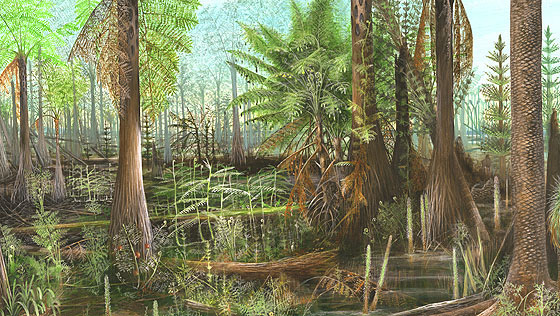The Age of Oxygen (400 million to 290 million years ago)
As plants became firmly established on land, life once again had a major effect on Earth’s atmosphere during the Carboniferous Period. Oxygen made up 20 percent of the atmosphere—about today’s level—around 350 million years ago, and it rose to as much as 35 percent over the next 50 million years.

- Late Carboniferous Period (Pennsylvanian)
- 318-299 million years ago
- Among the giant plants in the Carboniferous forests were Cordaites, an early relative of conifers; Calamites, a bushy horsetail; Medullosa,a seed fern (a plant with seeds and fern-like leaves); Psaronius, a tree fern; and Paralycopodites and Lepidophloios, lycopsids (scaly, pole-like trees with cones). Lepidophloios could grow to 40 m (132 ft), but most of today’s lycopsids, known as quillworts and club mosses, grow only a few centimeters high.
- Illustration by Mary Parrish © Smithsonian Institution
During the later part of the Carboniferous Period (Pennsylvanian), 318 to 299 million years ago, great forests grew on the land, and giant swamps filled low-lying areas. Usually when a dead plant or animal decays, microbes decompose it and combine its carbon with oxygen in the air to produce carbon dioxide, a greenhouse gas. But as great masses of dead plants became buried under swamps and out of contact with oxygen, the level of carbon dioxide in the atmosphere actually dropped. The world became cooler.
From Fossil to Fuel
After millions of years of heat and pressure, the buried remains of these giant plants were transformed into the large reserves of coal that we rely on today to supply so much of our energy. When we burn fossil fuels such as coal, oil, and natural gas, we release carbon dioxide from the dead plants and animals that were buried millions of years ago. Increasing carbon dioxide in the atmosphere makes Earth warmer.
Forecast: Cooling Trend
Early in the Carboniferous Period, Earth’s climate was warm. Later, glaciers formed at the poles, while equatorial regions were often warm and humid. Earth’s climate became similar to today’s, shifting between glacial and interglacial periods.
